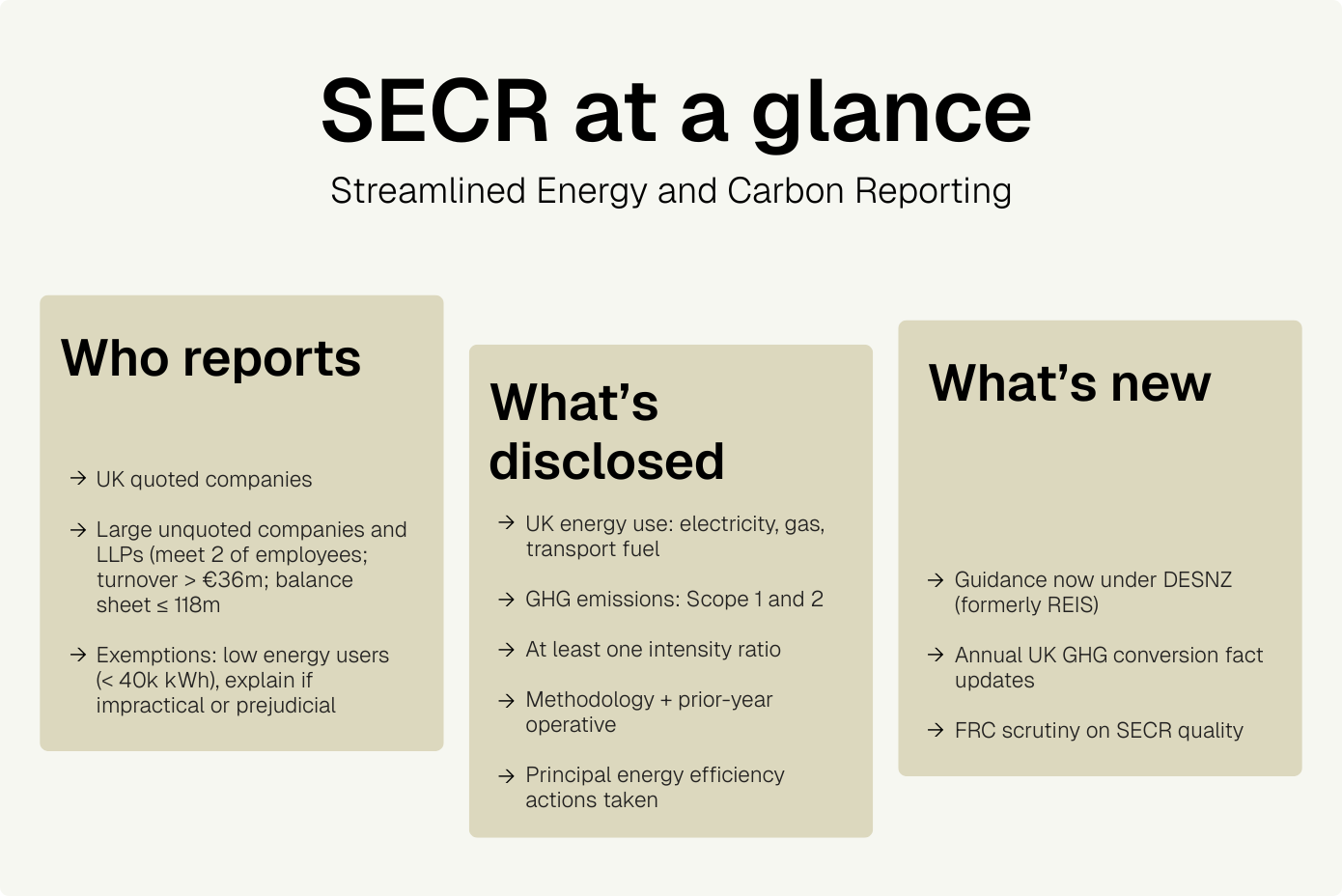What is SECR?
Streamlined Energy and Carbon Reporting (SECR) is the UK framework for disclosing corporate energy use and greenhouse gas (GHG) emissions to drive transparency and efficiency.
What are the SECR disclosure requirements in the UK?
- Who must report: UK quoted companies; large unquoted companies and large LLPs (meeting two of: >250 employees; turnover >£36m; balance sheet >£18m).
- Exemptions: low energy users (<40,000 kWh) or where disclosure is impractical/prejudicial – use the “comply or explain” principle.
- Core disclosures: UK energy use (electricity, gas, transport fuel); Scope 1 and scope 2 emissions; at least one intensity ratio; methodology; prior year comparatives; principal efficiency actions taken.
- Reporting location: Directors’ report (companies) or energy and carbon report (LLPs).

What’s changed?
- Following the BEIS (Department for Business, Energy, and Industrial Strategy) reorganisation, SECR guidance now sits with DESNZ (Department for Energy Security & Net Zero).
- Annual UK GHG conversion factor updates continue to influence totals and intensity metrics, particularly for electricity, which means you’ll want clear methodology notes and comparisons.
- The FRC (Financial Reporting Council) has raised the bar on quality. They expect well‑defined boundaries, consistent methods, and specific, non‑boilerplate efficiency actions.
- With ESOS (Energy Savings Opportunity Scheme) Phase 3 putting action plans front and centre, leading organisations are using SECR as the annual progress lens to track delivery, quantify savings, and show momentum.
SECR can change your organisation
Start by getting the foundations right. A robust methodology, aligned to the GHG Protocol and the latest UK conversion factors, paired with frictionless data governance gives you confidence. Set clear boundaries across your group, streamline data capture from finance, facilities, and fleet, and build an audit ready trail. Next, design intensity ratios that reflect how your business creates value: per unit output, per service line, or per £m revenue. Provide clarity on location-based versus (optionally) market-based electricity views so stakeholders can see the impact of procurement choices and decarbonisation pathways.
Turn insight into action. Tighten building controls and maintenance schedules, improve fleet behaviour, and optimise tariffs and demand profiles. Where it fits your strategy, explore high-quality renewable procurement with traceability to support credible claims. Integrate ESOS audit findings into SECR with prioritised measures and quantified paybacks, embedding delivery into your net zero strategy so you move from one-off reporting to continuous improvement.
Craft a report people can trust. Write concise, specific narratives about the efficiency actions you’ve taken, include prior year comparatives, and explain factor or boundary changes transparently to meet FRC expectations. Align SECR with investor decks, customer proposals, and any UK–EU reporting (CSRD/ESRS) for a coherent, market-ready story, and establish a repeatable operating model that reduces burden, improves data quality, and keeps performance on track.
The bottom line
SECR is often seen as a tick‑box exercise. In reality, Streamlined Energy and Carbon Reporting is a low-effort, high-impact opportunity: from cutting costs and boosting investor confidence to strengthening brand trust, all while keeping you fully compliant. At ClimatePartner, we produce SECR for many clients for little cost and effort and enable them to use this as a catalyst for greater corporate climate action.
Ready to move from reporting to results? Book a discovery session with our consultants to fast‑track your roadmap.
About the author
Marett Howlin is a Senior Sustainability Consultant at ClimatePartner UK. She brings experience in Portfolio and Programme Management to help clients achieve their climate goals through tailored, high-quality solutions. Her background includes roles in project management and market research.